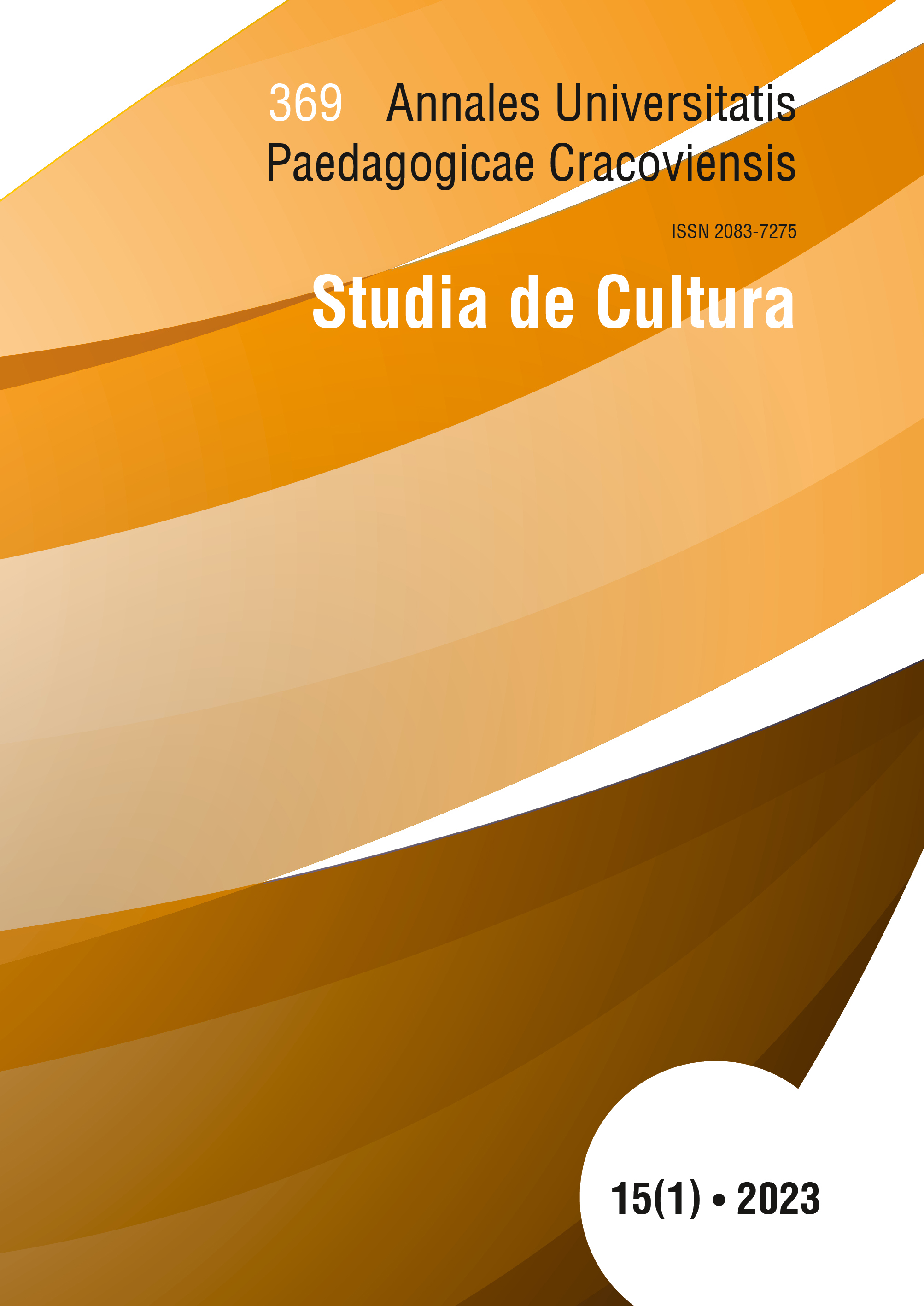Abstrakt
W niniejszym artykule spróbuję zastanowić się, czy binge‑watching, jako nowa kulturowa praktyka oglądania treści telewizyjnych, przyczynia się do zmiany środowiska medialnego, a tym samym stanowi znacznik kultury czy też kultur telewizyjnych. Ramę analizy stanowi zmiana praktyk w kulturze popularnej związanych z coraz większą popularnością usług streamingowych i poszerzającą się władzą konsumenta. Z jednej strony przyjrzę się napadowemu oglądaniu jako zjawisku globalnemu, z drugiej zaś wezmę pod uwagę różnice regionalne lub lokalne z nim związane. Spróbuję określić zróżnicowane wzorce jego użycia.
Bibliografia
Ahmed Azza Abdel‑Azim Mohamed. 2017. „New era of TV‑watching behavior. Binge‑watching and its psychological effects”. Media Watch no. 8(2). 192–207.
Zobacz w Google Scholar
Binge‑watching and contemporary television studies. 2021. Mareike Jenner (red.). Edinburgh.
Zobacz w Google Scholar
Brunsdon Charlotte. 2010. Bingeing on box‑sets: the national and the digital in television crime drama. W: Relocating television: television in the digital context. Jostein Gripsrud (red.). London. 61–75.
Zobacz w Google Scholar
Bury Rhiannon. 2017. Television 2.0: New perspectives on digital convergence, audiences and fans. New York.
Zobacz w Google Scholar
Castro Deborah, Rigby Jacob M, Cabral Diogo, Nisi Valentina. 2019. „The binge‑watchers journey: investigating motivations, contexts, and affective states surrounding Netflix viewing”. Convergence 27 (1). 3–20.
Zobacz w Google Scholar
Chambers Deborah. 2016. Changing media, homes and households: cultures, technologies and meanings. London – New York. 59–67.
Zobacz w Google Scholar
Dawson Tryon. 2020. „Researching binge‑watching”. Critical Studies in Television. The International Journal of Television Studies 15(3). 267–279.
Zobacz w Google Scholar
De Feijter Dimph, Khan Vassilis‑Javed, van Gisbergen Marnix. 2016. „Confessions of a ‘Guilty’ Couch Potato: Understanding and Using Context to Optimize Watching Behaviour”. W: TVX’16: Proceedings in the ACM International Conference on Interactive Experiences for TV and Online Video. New York. 59–67.
Zobacz w Google Scholar
English Oxford Living Dictionaries. Binge‑watching [hasło]. https://www.oxfordlearnersdictionaries.com/definition/english/bingewatching?q=binge+watching (dostęp: 3.02.2023).
Zobacz w Google Scholar
Jacobs Jason. 2011. Television, interrupted: pollution or aesthetic?. W: Television as digital media. James Bennett, Niki Strange (red.). London. 3065–3399.
Zobacz w Google Scholar
Jenner Mareike. 2020. „Researching binge‑watching”. Critical Studies in Television: The International Journal of Television Studies 15(3). 267–279.
Zobacz w Google Scholar
Kafka Peter. 2018. You can watch Netflix on any screen you want, but you’re probably watching it on a TV. Vox.com. https://www.vox.com/2018/3/7/17094610/netflix-70-percent‑tv‑viewingstatistics (dostęp: 3.01. 2023).
Zobacz w Google Scholar
Karasińska Agnieszka. 2016. „Pomiędzy ramówką a serialowym obżarstwem. Jak Polacy oglądają seriale”. Zeszyty Prasoznawcze 59(1). 51–63.
Zobacz w Google Scholar
Kisielewska Alicja. 2021. Antropologia telewizji. Telewizja w życiu codziennym w Polsce. Białystok.
Zobacz w Google Scholar
Merikivi Jani, Bragge Johanna, Scornavacca Eusebio, Verhagen Tibert. 2019. „Binge‑watching Serialized video content: a transdisciplinary review”. Television & New Media. 1–15.
Zobacz w Google Scholar
Mikos Lothar. 2016. „Digital media platforms and the use of TV content: binge‑watching and video on‑demand in Germany”. Media and Communication 4(3). 154–161.
Zobacz w Google Scholar
Mikos Lothar, Castro Deborah. 2021. Binge‑watching and the organisation of everyday life. W: Binge‑watching and contemporary television studies. Mareike Jenner (red.). Edinburgh. 142–165.
Zobacz w Google Scholar
Murgia Madhumita. 2016. „Inside Netflix: how Reed Hastings is building the first global TV network”. The Telegraph. 27.03.2016, https://www.telegraph.co.uk/technology/2016/03/26/inside‑netflixhow‑reed‑hastings‑is‑building‑the‑first‑global‑tv/ (dostęp: 03.02.2023).
Zobacz w Google Scholar
Perks Lisa Glebatis. 2021. Binge‑watching conditions and multitasking: the enjoyable ephemeral. W: Binge‑watching and contemporary television studies. Mareike Jenner (red.). Edinburgh. 105–124.
Zobacz w Google Scholar
Perks Lisa Glebatis, Steiner Emil, Pierce‑Grove Ri, Mikos Lothar. 2021. Binge‑watching audience typologies: conclusion. W: Binge watching and contemporary television studies. Mareike Jenner (red.), Edinburgh. 166–177.
Zobacz w Google Scholar
Riddle Karyn, Peebles Alanna, Davis Catasha R., Xu Fangxin, Schroeder Elizabeth. 2018. The Addictive potential of television binge watching: comparing intentional and unintentional binges. “Psychology of Popular Media Culture” 7(4). 589–604.
Zobacz w Google Scholar
Rubenking Bridget, Bracken Cheryl Campanella. 2020. Binge watching. Motivations and implications of our changing viewing behaviours. New York.
Zobacz w Google Scholar
Silverstone Roger. 1994. Television and everyday life. London.
Zobacz w Google Scholar
Słownik języka polskiego. Kompulsywny [hasło]. https://sjp.pwn.pl/slowniki/kompulsywny.html (dostęp 30.01.2023)
Zobacz w Google Scholar
Steiner Emil. 2017. Binge‑watching in practice: the rituals, motives, and feelings of Netflix streaming video viewers. W: A Netflix reader: critical essays on streaming media. Digital delivery, and instant access. Cory Barker, Myc Wiatrowski (red.). Jefferson. 141–161.
Zobacz w Google Scholar
Steiner Emil. 2018. Binge‑watching killed the idiot box: the changing identities of viewers and television in the experiential, streaming video age. Ph.D. dissertation, Temple University, Philadelphia, PA, USA. Retrieved from ProQuest. (10813061).
Zobacz w Google Scholar
Steiner Emil. 2021. Commercial constructions of binge‑viewers: a typology of the new and improved couch potato as seen on TV. W: Binge watching and contemporary television studies. Mareike Jenner (red.). Edinburgh. 85–104.
Zobacz w Google Scholar
Stolz B.G. 2021. National, transnational, transcultural media: Netflix – the culture‑binge. W: Binge‑watching and contemporary television studies. Mareike Jenner (red.). Edinburgh. 180–199.
Zobacz w Google Scholar
Stolz B.G., Watts Robert, Jenner Mareike. 2021. Transnational Bingeing: Conclusion. W: Binge Watching and Contemporary Television Studies. Mareike Jenner (red.). Edinburgh. 201–204.
Zobacz w Google Scholar
Sztąberek Maciej. 2018. „Platforma strumieniowa Netflix– domena VOD czy nowa forma telewizji jakościowej? Historia i sposoby dystrybucji”. Panoptikum 20(27). 10–32.
Zobacz w Google Scholar
Turner Graeme. 2019. „Television studies, we Need to Talk about »Binge‑Viewing«”. Television and New Media 20(2). 1–13.
Zobacz w Google Scholar
Walton‑Pattison Emily, Dombrowski Stephan U, Presseau Justin. 2018. „»Just One More Episode«. Frequency and Theoretical Correlates of Television Binge Watching”. Journal of Health Psychology 23(1). 17–24.
Zobacz w Google Scholar

Utwór dostępny jest na licencji Creative Commons Uznanie autorstwa – Użycie niekomercyjne 4.0 Międzynarodowe.
Prawa autorskie (c) 2023 Annales Universitatis Paedagogicae Cracoviensis | Studia de Cultura

